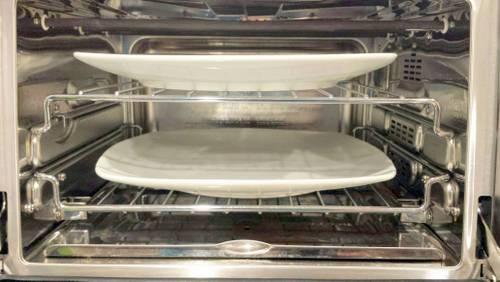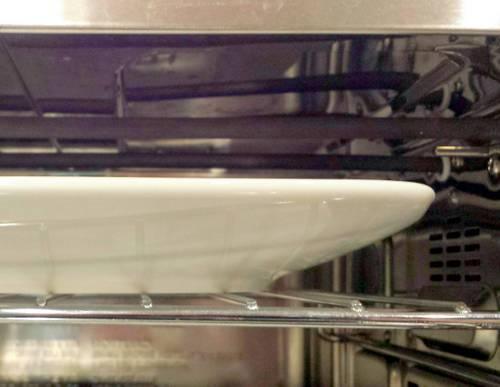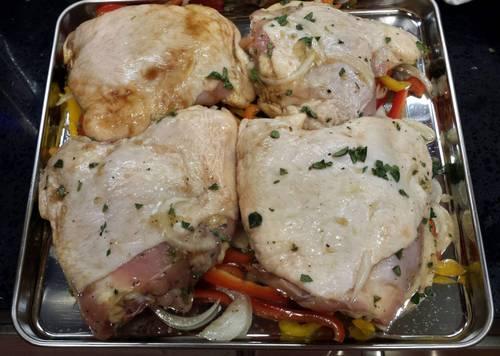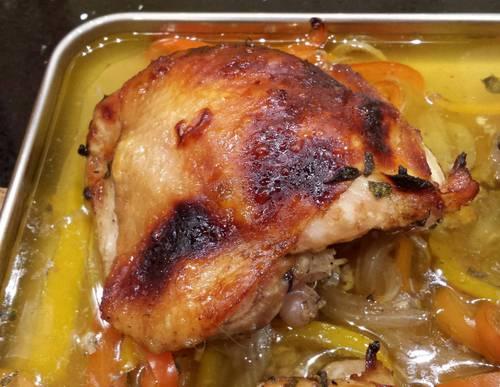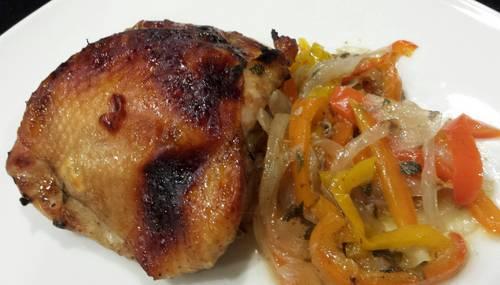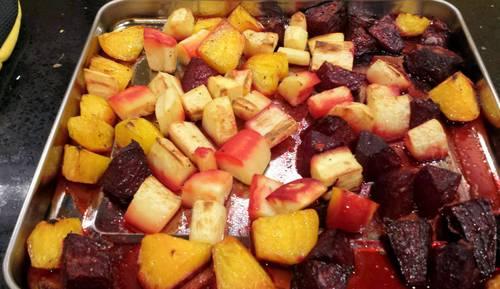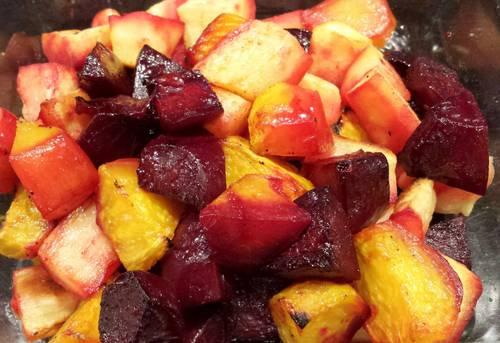
SJMitch
participating member-
Posts
126 -
Joined
-
Last visited
Content Type
Profiles
Forums
Store
Help Articles
Everything posted by SJMitch
-
So I ordered a second shelf to try reheating two plates of food at once (since it does it so much better than the microwave and I often want to heat two plates of food). Alas, the spacing isn't quite right. Here is the shelves in the low position with our dinner plates, leaving not enough room to put food on the bottom plate, and the top of the plate usually scrapes as you put it in: Here are the shelves with the top one inverted: This might work as long as the food is very flat, but still very little clearance to top heater elements (a closeup): And no, you can't fit two racks into the same slot. Haven't tested the heating ability for two plates of food yet, just the clearance issues. A straight rack in the top slot would be ideal. I went to Bed Bath and Beyond and they had a Cuisinart Steam oven on display with the other ovens. I tried the racks from the other toaster ovens they had and none fit. The mini Breville was so close, but just a little too wide. Anyone know a source for a straight, rather than offset, rack that might fit?
-
The chicken meat was moist and flavorful, the aroma from the pepper/onion bed was good. Couldn't tell the effect of the vinegar marinade on the chicken, but it added slight tang to the peppers. We ate two thighs right away and on the next day I shredded the meat from the other two thighs to make a chicken salad (with greens, fruit, and nuts; not a mayo based salad). The meat was still moist. The temp/time cooked the thigh meat fully, with no parts overcooked.
-
I tried the Vinegar Chicken with Peppers recipe from the Cuisinart manual. The liquid from the vegetables and chicken filled the baking tray but did not spill over. Here it is before going in to the oven: Here it is after 1 hour at Bake Steam at 300 degrees: And here it is plated: I reserved the liquid for soup the next day. Although the skin looks nicely roasted, it was not crisp. Chicken meat was very moist.
-
Thanks for the pointer to the extra shelf, Mitch. I will give a try to see if two plates can fit and cook in the same time -- might be too much mass to cook in 15 min still, but will try. Love the look of the whole cauliflower -- any pointers to good marinades or do you just wing it, chefmd?
-
When I started using a Gaggenau steam oven I found we almost never used the microwave anymore, since the steam oven's 'regenerating' setting reheats a plate of fridge-temp leftovers in 12-15 minutes and with much better results than the microwave. And I was willing to wait 15 minutes for great food. The Cuisinart manual suggests 'Bake Steam' at 250 degrees for 20 minutes. However, I found it left most food a little dryer than I liked. But .. "Super Steam" at 250 for 15 minutes has worked great for reheating wet leftovers (stews, curries, stir fries, basically anything you don't want dried out or crispy). I wonder if there is a way to do two shelves of plates in it.
-
And salmon. Steamed 1 lb fillet at 210 for 18 min on bed of fennel, shallot and orange slices. Then broiled for 10 min to crisp the skin. Here is half of it plated.
-
Thanks for the pointers to the Williams Sonoma sale! Got 2, one a floor model without box for an extra discount, too. Although I'm lucky to cook often in a kitchen with a Gaggenau combi wall oven, it's good to have the steam oven option elsewhere, too! It will take a bit to calibrate to cooking in the Cuisinart. Here is my first effort at beets, following the Cuisinart manual recipe suggestion of steam-broil at 500 for 30 min. I used peeled and cut red beets, yellow beets, and parsnips. The steam broil left the pan still watery, so cleanup was easy. Parsnips very soft, beets firm but cooked through. The pan just out of the oven: Close up:
-
FWIW, I find your photo more appealing than the one in MC. The one in MC makes the eggplant look under cooked and unappetizing. I'm considering making it now, when based on the book photo I had no interest.
-
"Modernist Cuisine" by Myhrvold, Young & Bilet (Part 3)
SJMitch replied to a topic in Cookbooks & References
I'd like the errata to be separated by printing as well. If you have the second printing, as I do, it's a bit of a pain to spend time checking corrections that are already corrected. -
If you were following the video process you posted (the microwave version, similar to New England Cheese Co's recommended method), did you microwave the curds right after the first draining of the whey? The curds need to be kept uncomfortably hot for the kneading (either with multiple MW sessions or dunks in very hot water bath). Curd temp of 135F is recommended. They probably won't start forming a mass until kneaded when hot.
-
Added calcium chloride helps make a firmer curd when using pasteurized milk. I'm fairly certain it will actually interfere with proper stretching with mozzarella and is not used for that cheese. (and checking now, New England Cheesemaking Company agrees.)
-
Because of the humidity settings, the wet bulb temperature in the Gaggenau combi oven set at high humidity will be higher than in a dry oven. I haven't done it yet, but after seeing the wet bulb curves in Modernist Cuisine for the Rational combi oven, I've wanted to measure and plot them for my Gaggenau combi oven for comparison and to see how variable Gagg's temp control is. I'm partially hoping someone will beat me to it, though, so I won't feel the need to rig up equipment. In any case, I get much higher oven spring when placing the dough onto the preheated cast iron pan than onto a thin pan. A stone should behave similarly. The Gagg accessories are very overpriced, so it's no big deal if they don't have a stone for the steam oven. The stone I listed is less than $10 (though as I mentioned, I already had an iron platter that fit). Also, standard hotel pans (1/3, 1/2, and 2/3 sizes) fit on the steam oven rails and can be found in any restaurant supply shop for around $10 each.
-
Is that a new accessory for the Gaggenau steam oven or are you thinking of the stone (plus extra heating element) they sell for their regular convection oven? The interior of the steam oven is much smaller than the regular ovens, so it couldn't be used in the steam oven. (nor does the steam oven have the port for the extra heating element that works with their baking stone and roaster accessory).
-
I've done a few loaves with the Gaggenau steam oven. I've used two methods depending on how substantial I want the crust to be. One way is to preheat the oven on the 100% steam setting, and then after 3-10 minutes (depending on how long you think steam is important in the baking of breads) turn it to 0% steam so it vents the humidity. This did make a decent crust. For a heartier crust, I've be able to add even more steam by first doing the '100% steam' setting with preheat, then putting the bread in, switching the oven to 0% and then holding the mist button [this button is not available when the oven is set to 100% steam] to add more, and switching it back to 100% steam for some minutes, and then back to 0% to finish off. In either case, I preheat with a cast iron platter dusted with flour or cornmeal, but there are some stones that fit the Gaggenau steam oven (e.g. the American Metalcraft Stone12 fits). The Gaggenau does top out at 450F. Here's a pic of a loaf of 5-minute-a-day bread baking in the steam oven:
-
Although I like Yelp, I consider 90 to 95% of the reviews on Yelp to be nearly worthless. For folks who are willing to put in the time to find the signal in the remaining 5 to 10%, Yelp can be helpful (I mostly use it to find new places, hole-in-the-wall shops that serve unique cuisine not broadly available, unusual dishes or preparations, shops that use ingredients from other local suppliers I admire, or to fulfill cravings for specific ingredients -- e.g. "I want some a-choy today, can I find a Taiwanese place with it on the menu?"). For many people, it's just not worth it. Yelp's power is overrated. It's really not worth it for a business to stress out or even waste any effort or concern about a bad or misleading review. This is especially true when the opinion expressed is subjective and vague. Savvy readers weed these out on their own. It's similar to reviews on Amazon. You can tell when someone just doesn't get it about a product on Amazon or has an ax to grind. If you get a bad review, even if it is unfair, let it go. Trust that the type of customer that you'd want at your business is smart enough to discriminate between reliable and unreliable reviews. The only time it might hurt business is when it is a trend among the majority of reviews. This typically happens when there really is an issue with the business or when someone has figured out how to game the system and is willing to open lots of a accounts and even spend 10s or 100s of hours to build the reputation of those accounts, all with the intention of attacking a competitor. But then it's not just one or two reviews. It's dozens or hundreds, with new ones added all the time. Small fry shills are usually caught in the same filter that prevents passionate but genuine new Yelp users from getting their first few reviews posted.
-
Review sites like Yelp can be helpful, but you have to put in a lot of time or do intelligent searches to get decent info out of them. I don't find much value in the overall ratings, but do get value out of some of the detail in the reviews. Oddly, I often find good restaurants to try based on bad reviews on Yelp. Such as reviews of Ethiopian restaurants that complain their injera is 'too sour' (what? they make their own and actually ferment it properly instead of dousing it with soda -- I'm there!). Or 'bad' reviews of Pakistani dishes or Mexican goat stews complaining about bones, or complaints about inedible parts in soups that should have them (e.g. lemongrass, thick ginger slices) -- instead of warning me away it tells me there is likely to be well-spiced and flavorful dishes to be had. One review of a local coffee place complained that they were weighing the beans before making a pourover and about the time it took -- the reviewer thought they should make a batch in advance and should just know how much to put in. From that bad review, I knew that was a coffee shop that really cared about the quality of the coffee they served. I also find complaints about 'small portions' to often be an indicator of quality as long as it isn't a sudden change for the place (it's not a perfect signal, but it's once piece of evidence). Also, I've had better luck following the recommendations of reviewers that are more balanced and are able to include some of the shortcomings of the place in the review (no place is perfect). Then I can decide how important that fault is to me. Restaurant completely family run and has disinterested kids as servers and can't handle lunch rush but parents can cook up a storm? -- only go off hours. Before I learned to read the reviews critically, I was in a new town and tried a Mexican restaurant with an overall good rating. The food was sad. I wrote my first Yelp review, being detailed about what was wrong with the food and giving them a low rating. It was promptly 'removed', or in Yelp terminology, 'filtered'. I lost interest in Yelp for a few years until I learned that on Yelp, reviews from new users often don't stick until the user establishes a track record of many reviews and had other indicators they are not a shill just for or against a specific place (it helps to have a photo on your profile, use a non-joke handle and fill out your profile more). To test it, I started to review to other places and cleaned up and filled out my profile. After 10 or so reviews and regular use of the site, my 'bad' first review from a few years ago was reposted. You can't expect to join Yelp write a single review strongly pro or con and have it stay long term. They have automated filters against new users to keep shills out and it catches most new users. There is an appliance store near me that solicits reviews. They have over 100 'filtered' and unseen reviews. I guess they are hoping they get enough on an ongoing basis that the day or two they stay up will be enough to sway readers. Soliciting reviews is against Yelp policy. When I see 100s of 'filtered' reviews, I know it is a place to avoid. Really good or really bad places will always have a few 'filtered' reviews since those places entice new reviewers in who don't know that just reviewing 1 or 2 places with a blank profile won't work. I like now having an established track record on Yelp and knowing that if a place knocks my socks off and I write a total fanboy review it will stick. (same for bad ones). One thing I don't like about Yelp is that I now can't be completely honest -- if a small local place is decent but not steller and yet I'm likely to frequent them, I either can't rate them or have to rate them highly since they will know it is me and for these places it would be too rude to do otherwise and generate bad feelings (the new places now always seem to follow Yelp with a bit too much interest). I usually rate them 5 stars, start off with all the good stuff and then try to have a vague comment or two about their shortcomings to try to be a bit more helpful to readers. Restuarants have offered me perks for my reviews -- thankfully all of them have been after the review was written. It always makes me uncomfortable since I can't always tell if it is for the review (which I will then decline) or because I am seen as a regular (which I will accept).
-
My understanding is that AFA was a highly leveraged company and therefore overly sensitive to demand fluctuations. I.e. poor managment is the cause. Also, it's chapter 11 bankruptcy, so they aren't being 'hounded out of business' yet (and maybe never). They claim they only use the ammoniated beef at the request of their customers. That leads me to believe that it is the temporary drop off in ground beef demand that is the cause. If it was simply consumers moving from ground beef with ammoniated trimmings to untreated ground beef, there wouldn't be a drop off, their food service clients would just order it without the ammoniated parts. Why would consumers back away from ground beef in total instead of just ground beef with the ammoniated trimmings? I suspect lack of labelling is the cause: if the consumer doesn't have confidence in the product, they won't buy it at all. Accurate labels would help restore that confidence. It would also allow the cheaper ground beef to remain in the food supply for those who are happy to have cheaper product and agree the ammoniated trimmings are safe. Heck, this labeling works for somewhat similar (but different) meat product that got bad press as well: Mechanically separated meat. Chicken processd this way is required to be labelled 'mechanically separated chicken'. Some suppliers have moved away from it (e.g. McDonalds), while others continue to use it and consumers continue to buy it happily (e.g. Slim Jims). So besides bad management, lack of accurate labeling is likely also a major cause of beef processors' woes.
-
I bought the competitor to Soda Stream: the Primo Flavorstation ($80 at Lowes). The advantage to it is that it uses standard non-crippled paintball-size tanks, so you can just take it to a CO2 supplier and get them refilled. And if you want a spare tank you aren't limited to the Primo branded tank; any standard 20oz CO2 tank will screw in just fine. I lucked out and found a quality refill place less than a mile from the house. $5 a fill. They said they fill a lot of tanks for kegerators too. And showed me the parts I'd need if I wanted to hook a bigger tank up. I might do so, mostly because the tank screws in to plastic and I worry about the longevity of the unit. With a hose and a quick connect, I can avoid wear and tear on the plastic connection. SodaStream has a patent on the integrated pressure release, so with Primo, after you inject the CO2 you have to press a different button and purge the excess gas, but it's not a big deal. Other than that it works exactly like the SodaStream. While you can buy adapters for the SodaStream, they tend to be expensive. The Primo needs no modification.
-
Apparently, many folks care whether the parsnips were dug up before (and stored, as many are) or after a winter freeze (and thus may have more sugar). News to me, too (but then I live where the ground doesn't freeze much in winter).
-
You remember correctly about the temp, it does only go up to 450F. It has no broiler. It would also be rather small for an only oven. Not counting the microwave we actually have 3 ovens: a large gas oven with rotisserie and fantastic broiler, a mid-size regular convection wall oven, and the steam oven. I'd gladly trade the midsize oven for another steam oven, but not the rotisserie/broiler gas oven. I would not recommend it as an only oven unless one never does any broiling and doesn't need a large size oven. For reheating food, the temp range I use is 230F-280F and the oven is well-designed, so I don't find it heats up the kitchen. I put the food in on the serving plate into the cold oven, turn it on and come back in 15 minutes. Unlike with a microwave, I don't need to bother covering it, so other than the time (15 minutes versus 5 to 7) I find it more convenient than the MW. It also holds far more than my microwave so I can reheat multiple people's plates at once. One downside is that the plate gets very hot as well, so we keep a stack of side towels near the oven. If you live near a Purcell Murray you can go test one out. They have both free demos (with food) and will let you schedule a time to bring your food and cook with it. That was what convinced us it was worth it.
-
We have the Gaggenau combi steam oven and it was the best purchase we made for our kitchen remodel. We use it several times daily. It is a little more flexible than the Wolf. For one, it is plumbed in, so no refilling of water tanks needed. Besides '100%' steam it has what it calls 60% and 80% steam for midrange levels of steam. It also has an option labelled '30%' steam, but if you read the manual, this just means that the oven vent is closed and the oven gets humidified from the steam from the food alone. The Wolf also has this vent-closed setting. I've found that 60% and 80% settings aren't critical, and you can approximate them by first cooking at 100% and then drying out the food some with a 0% or full convection setting. If you look through the recipes in, say, Modernist Cuisine, they don't really utilize the midrange settings, recipes are usually done either with standard convection (0% added steam) or 90/100% steam. So the fact that the Wolf lacks them is not really a big deal. Surprisingly, the function we use it most frequently for is reheating a plate of leftovers. Uncovered, or loosely covered, a microwave cooks fast but dries out the food. The steam oven heats a plate of fridge temp food reasonably quickly (about 15 minutes starting with a cold oven), and keeps it moist. We haven't used our microwave to reheat leftovers since we got the steam oven. Once you try reheating in a steam oven, I think you'll be hooked, at least when you can spare a little extra time. Cooking with steam is also great for vegetables (keeps them sweeter than boiled), for flans and custards, and yes, for meat roasts (which I prefer to start at 100% steam and then switch to 0% at the end). The cavity is smaller than a standard wall oven (at least on the Gaggenau) but this is a plus -- it preheats quickly. You can cook with steam in a regular steam pot on the stove, or (to control dry bulb temp in addition to adding steam) put a tray of water in a oven, but the steam ovens make it so much more convenient. Plumbed-in is even more convenient but the plumbed Gaggenau new is very expensive, although there are some prior models still available here and there for much less. We use our so much I wish we had two! With two cooks and multiple dishes, there is usually competition for the steam oven.
-
You can use Amazon's "Search Inside the Book" feature to look for specific ingredients. Or buy the PDT Barnes and Noble Nook ebook (readable on PC, Mac, IOS, Android). Oddly, Amazon doesn't have an ebook version. I've found the fast easy searching of Cocktail ebooks so useful, that I bought ebook versions of ones I already had the hardcover in and now buy new ones ebook only.
-
One of our local ramen shops makes an okara salad. It's quite refreshing and good. This recipe looks similar to what is served there.
-
The WSJ article about her by her son is very cool. There's a fun photo of her on the back of a motorcycle with whom? The owner of Sanders 1907.
-
"Modernist Cuisine" by Myhrvold, Young & Bilet (Part 3)
SJMitch replied to a topic in Cookbooks & References
Thanks for pointing this out, I saw the last updated date hadn't changed and assumed the web listings weren't either. After you mentioned this I checked and two corrections I sent back in 7/2011 were also now listed there as well. They should update the pdf and 'last updated'. I wonder just how many people have been sending in possible duplicate corrections all this time. It would save work on our and their end if they kept it more up to date and made it clear when it was updated.


